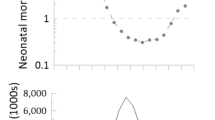Abstract
Fetal growth retardation is at present the major obstacle for further reduction in preterm births. After 25 years of continuous decline in the preterm birth rate in France from 6.9% in 1972 to 4.4% in 1981 and 3.8% in 1989, there has been an increase to 4.5% in 1995. The major new fact is the progressive increase of medically induced preterm births, mostly related to fetal growth retardation. Spontaneous preterm births have continued to decrease throughout all these years.
Similar content being viewed by others
REFERENCES
Papiernik E, Bouyer J, Dreyfus J, Collin D, Winisdorffer G, Gueguen S, Lecomte M, Lazar P. Prevention of preterm births: A perinatal study in Haguenan, France. Pediatr 1985;76:154–158.
Bréart G, Blondel B, Tuppin P, Grandjean H, Kaminski M. Did preterm deliveries continue to decrease in France in the 1980s? Paediatric Perinatal Epidemiol 1995;9:296–306.
Kramer MS, McLean FH, Boyd ME, Usher RH. The validity of gestaitonal age by menstrual dating in term, preterm, and postterm gestations. J Am Med Assoc 1988;260:3306–8.
Goldenberg R, Davis RO, Cutter GR, Hoffman HJ, Brumfield CG, Foster JM. Prematurity, postdates and growth retardation: The influence of use of ultrasonography on reported gestational age. Am J Obstet Gynecol 1989;160:462–70.
Wilcox M, Gardosi J, Mongelli M, Ray C, Johnsom I. Birth weight from pregnancies dated by ultrasonography in a mulitcultural British population. BMJ 1993;307:588–91.
Alexander G, Kogan M, Martin J, Papiernik E. What are the fetal growth patterns in singletons, twins and triplets in the United States. In: Keith L, Papiernik E, editors. Mulitple gestation. 1998.
Papiernik E, Richard A, Tafforeau J, Keith L. Social groups and the prevention of preterm births in a population of twin mothers. J Perinat Med 1996;24:669–76.
Lowry MF, Stafford J. Northern region twin survey. J Obstet Gynecol 1988;8:228–34.
Chervenak FA, Youcha S, Johnson RE, Berkowitz RL, Hobbins JC. Twin gestation. Antenatal diagnosis and perinatal outcome in 385 consecutive pregnancies. J Reprod Med 1984;29:727–30.
Persson PH. Fetal growth curves. In: Sharp F, Fraser RB, Milner RDG, editors. Fetal growth. London: Royal College of Obstetricians and Gynecologists, 1989
Ott WJ. Intrauterine growth retardation and preterm delivery. Am J Obstet Gynecol 1993;168:1710–5.
Weiner CP, Sabbagha RE, Vaisrub N, Depp R. A hypothetical model suggesting suboptimal intrauterine growth in infants delivered preterm. Obstet Gynecol 1985;65(3):323–5.
Tamura RK, Sabagha RE, Depp R, Vaisrub N, Dooley SL, Socol ML. Diminished growth in fetuses born after spontaneous labor or rupture of membranes. Am J Obstet Gynecol 1984;148:1105–10.
Secher NJ, Kern Hansen P, Thomsen BL, Keiding N. Growth retardation in preterm infants. Br J Obstet Gynaecol 1987;94:115–20.
Marsal K, Persson PH, Larsen T, Lilja H, Selbing A, Sultan B. Intrauterine growth curves based on ultrasonically estimated foetal weights. Acta Paediatr 1996;85:843–8.
Gardosi J, Mongelli M, Wilcox M, Chang A. An adjustable fetal weight standard. Ultrasound Obstet Gynecol 1995;6:168–74.
Hadlock FP, Harrist RB, Martinez-Poyer J. In utero analysis of fetal growth: A sonographic weight standard. Radiology 1991;18:129–33.
Brenner WF, Edelman DA, Hendricks CH. A standard of fetal growth for the United States of America. Am J Obstet Gynecol 1976;126:555.
Mamelle N, Munoz F, Martin JL, Laumon B, Grandjean H. pour le groupe de travail AUDIPOG. Croissance foetale à partir de l'etude AUDIPOG. J Gynec Obstet Biol Reprod 1996; 25:71–7.
Amiel-Tison C. When is it best to be born? A pediatric perspective on behalf of the fetus. In: Amiel-Tison C, Stuart A, editors. The newborn infant: One brain for life. Paris: Les Editions INSERM, 1994.
Amiel-Tison C, Pettigrew A. Adaptive changes in the developing brain during intrauterine stress. Brain Dev 1991;13:67–76.
Challis JRG, Patel FA, Pomini F. Prostaglandin dehydrogenase and the initiation of labor. J Perinat Med 1999;27:26–34.
Korehitis C, Ramirez MM, Watson L, Brinkman E, Bocking AD, Challis JRG. Maternal CRH as predictor of impending preterm birth. J Clin Endocr Metab 1998;83:1585–9.
Papiernik E, Charlemain C, Goffinet F, Paul G, Keith LG. Vaginal bacterial colonization, the uterine cervix and preterm births. Perinat Neonat Med 1998;3:98–102.
Meis PJ. Indicated preterm births: A review. Prenat Neonat Med 1998;8:113–5.
Kramer MS, Platt R, Yang H, Joseph KS, Wen SW, Morin L, Usher RH. Secular trends in preterm birth—A hospital based cohort study. JAMA 1998;280:1849–54.
Author information
Authors and Affiliations
Corresponding author
Rights and permissions
About this article
Cite this article
Papiernik, E. Fetal Growth Retardation: A Limit for the Further Reduction of Preterm Births. Matern Child Health J 3, 63–69 (1999). https://doi.org/10.1023/A:1021897125652
Issue Date:
DOI: https://doi.org/10.1023/A:1021897125652




